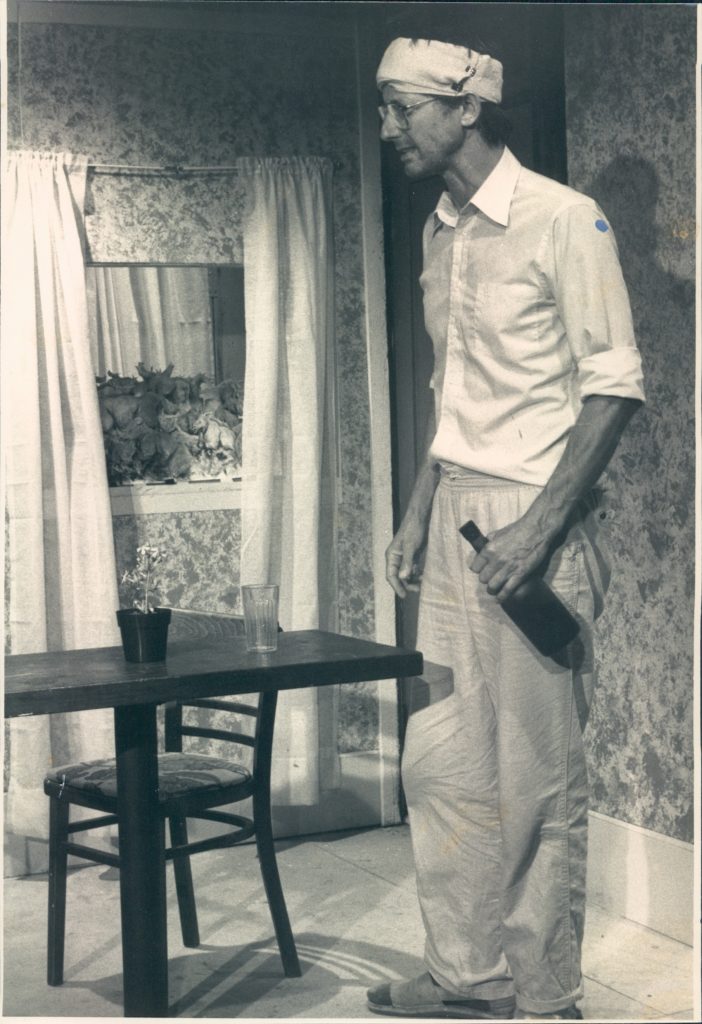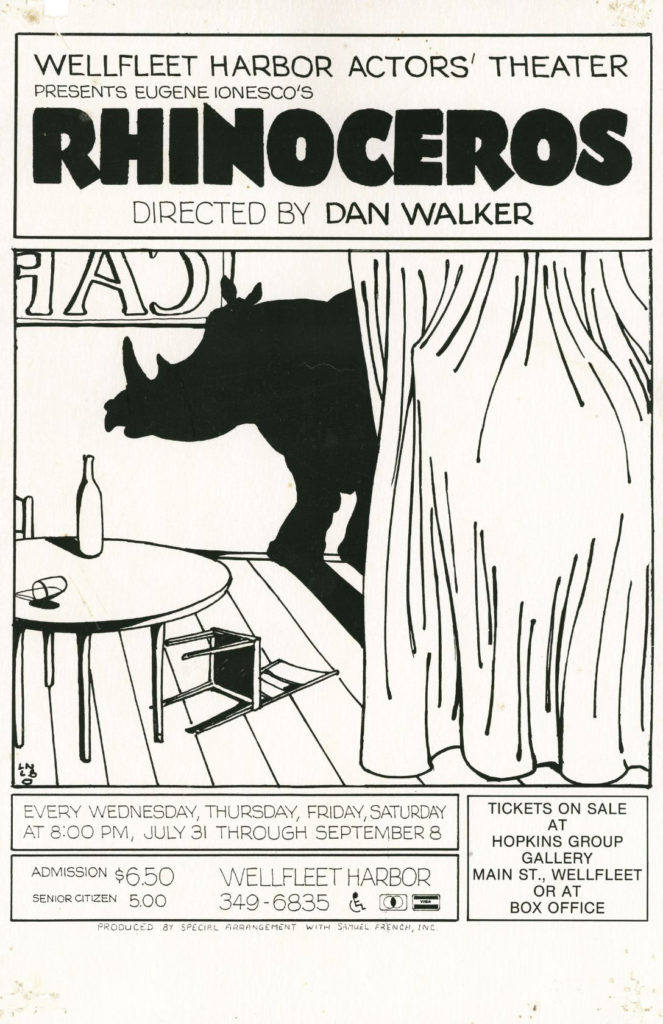
WELLFLEET — Spoiler alert: Eugene Ionesco’s Rhinoceros, which opens this weekend at the Wellfleet Harbor Actors Theater, ends with a defiant declaration. “I’m not capitulating!” shouts the last man on earth.
It’s not a bad motto for a troupe that was shut down on its opening weekend back in 1985 and nearly collapsed under crushing financial burdens just a few years ago, yet lives today to celebrate the beginning of its 35th season as an Outer Cape institution.
“We’re extremely grateful to be here,” said Christopher Ostrom, WHAT’s executive and artistic director. “I think there are very few places where a theater that produces this type of challenging work could survive and thrive.” Asked why 2019 was the year to bring back Rhinoceros, the first play staged by WHAT, he said, “Thirty-five years is basically a generation. And Rhinoceros is an incredibly timely play for the age we’re living in.”
Ionesco wrote the play in 1959. It’s a cautionary absurdist allegory based on his experiences in Romania in the run-up to World War II, as he watched friends and family, one by one, capitulate to totalitarianism. Rhinoceros’s paranoia — and mordant humor — must have struck a chord in the mid ’80s at the height of the Cold War, making it the perfect play to launch a scrappy upstart theater company.
But WHAT almost wasn’t.
Dick Morrill was a busy man in the summer of 1985. He was there when Kevin Rice, a WHAT founder, pitched Rhinoceros as their maiden production. He accompanied director Dan Walker as he strolled through the crowds on the Fourth of July, still looking for actors less than four weeks before opening night. He helped renovate the waterfront building that would become WHAT’s first home.
And Morrill played Berenger, the lead in Rhinoceros.
“They came to me and said, ‘We need you to be Berenger,’ ” Morrill recalls. “I said, ‘What are you talking about? I’m not an actor!’ I was building the sets. I was wiring the switches.” But Morrill’s behind-the-scenes experience along with a few bit parts made him a stage veteran in a cast made up of earnest amateurs and first-timers. The 1985 production was a labor of love off stage as well, with local artists offering their talents to help a fledgling theater company get off the ground. “A wrought iron railing, ivy crawling up the windows — intricate stuff,” said Morrill.

July 31, 1985: Opening night. A huge success. Well, as huge as a theater that seated about 30 people could be. But the hard work had paid off, and the troupe looked forward to five more weeks of healthy ticket sales and applause. But the next night a sympathetic selectman flagged Morrill down just before the curtain. “Dick, they’re going to close you down,” he said.
A town regulation required all new businesses to have their own onsite parking. And WHAT had exactly zero spaces — though it was in the middle of a veritable sea of them, between Mayo Beach and the town marina. So the troupe drew up a petition to collect the 125 signatures needed to get on the agenda at the next selectmen’s meeting.
“The way it was worded,” Morrill said, “I remember people saying, ‘Wellfleet Harbor? You can’t close the harbor!’ ” The petition had over 500 signatures by the time it was submitted. Ionesco would have loved it.
A few days later the town issued a waiver, and Rhinoceros reopened the following weekend. “We were closed for two days — but we got great PR!” Morrill chuckled. “It was in all the newspapers, and after that we sold out every night.”
As Berenger, Morrill was the last person on stage at the end of each performance, after the rest of the cast (and the world) had succumbed to “rhinoceritis.” So it’s fitting that he returns to WHAT as the troupe returns to the play that gave it its start. This time, he’s playing dual roles — the “Old Gentleman” and the evocatively named “Mr. Papillon” — giving him not one but two opportunities to experience “rhinoceration.”
This new staging of Rhinoceros has another connection to the 1985 production that may not be as obvious, but it’s no coincidence that the directors of both versions share a last name. Having directed a number of plays for WHAT (most recently last season’s An Act of God), Daisy Walker now finds herself following in her father Dan’s three-toed footsteps.
“We’ve had such a strong relationship with Daisy over the years, and she has a very deft hand when it comes to comedy,” said Ostrom. “I approached her and said, ‘Would you be interested in doing this?’ I don’t think I even got all the words out of my mouth, and she said yes.”
Ostrom is also excited about another “happy coincidence” related to Rhinoceros.
“In talking about producing this season, Orson’s Shadow came up kind of organically,” Ostrom said. “It’s a really interesting look into the lives of famous and legendary figures.” Playwright Arthur Pendleton considered what might have happened in 1960 when Orson Welles directed Laurence Olivier, Joan Plowright, and Vivian Leigh in a production of Rhinoceros.
Ostrom decided to produce the two plays together. “It seemed to make a lot of sense to do them in rep, and stage them on alternate nights,” he said. With half the cast of Rhinoceros pulling double duty with major roles in Orson’s Shadow, Ostrom hopes that audiences will follow suit and attend both plays.
Rhinoceros runs from Sept, 7 to 28, with previews on Sept. 5 and 6. Orson’s Shadow begins Sept. 14 and runs through the 29th, with previews on Thursday, Sept. 12 and Friday, Sept. 13. For exact dates and times, see what.org.



